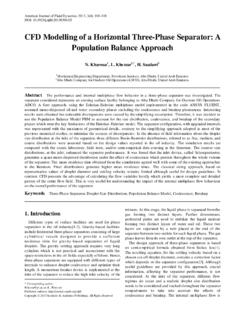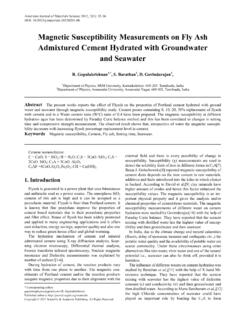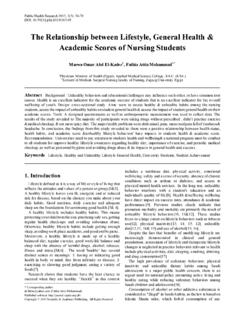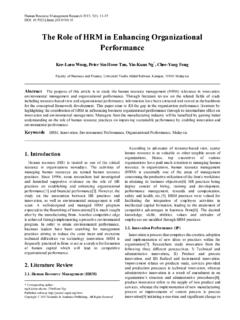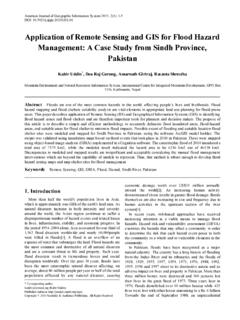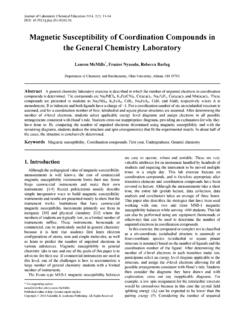Transcription of System Theories: An Overview of Various System Theories ...
1 American Journal of Systems Science 2013, 2(1): 13-22 DOI: System Theories : An Overview of Various System Theories and Its Application in healthcare Charissa P. Cordon Collaborative Academic Practice, Nursing-New Knowledge and Innovation, University health Network, Toronto, ON, Canada Abstract Throughout the course of human evolution, humans have been solving complex problems. In this paper, Various System Theories such as General systems theory , Chaos theory , Complex-Adaptive Systems, and Integral theory are described and discussed within the context of the human body. Different systems of varying context, such as: (1) when facilitating sustainable changes in organizations; (2) when promoting the unification of health care teams to enhance patient care ; and (3) when explaining treatment principles in oncology, are also described and discussed in this paper, using systems theory as a framework.
2 systems theory has many applications, not only in leadership and organization, but also in oncology. Leaders need to be systems thinkers in order to facilitate sustainable change in their organizations. Keywords Systems Theories , health care , General systems theory , Chaos theory , Complex-Adaptive Systems, Integral theory , Oncology 1. Introduction Throughout the course of human evolution, humans have been solving complex problems. There are multiple, hierarchical, and complex systems that exist in the world, which make problem solving challenging. Philosophers like Aristotle and Descartes have conceptualized how to best address systemic complex problems. Aristotle described the importance of looking at systems as a whole, and introduced the notion that the whole is greater than sum of its parts.
3 Descartes, on the other hand, introduced the idea of solving problems by breaking down large complex problems in to smaller manageable portions. Over the years, these philosophies have evolved, and Various Theories about systems have emerged. It is important to understand how systems work, in order to affect sustainable change. There are many different types of systems, ranging from mechanical systems such as clocks, to computer systems, and natural/organic systems. Systems involving humans tend to be the most complicated. The goal of this paper is to provide healthcare professionals with concrete examples of how System Theories can be used in analyzing complicated issues in health care . In this paper, a definition of a System is provided, and Various types of systems are identified.
4 Various systems Theories such as General systems theory , Chaos theory , Complex-Adaptive Systems, and Integral theory are * Corresponding author: (Charissa P. Cordon) Published online at Copyright 2013 Scientific & Academic Publishing. All Rights Reserved described and examples are provided within the context of the human body. Finally, using systems theory as a framework, Various issues within the health care System is discussed in detail such as: (1) when facilitating sustainable changes in organizations; (2) when promoting the unification of health care teams to enhance patient care ; and (3) when explaining treatment principles in oncology. 2. Systems and Systems Thinking A System is defined as a regularly interacting or interdependent group of items forming a unified whole [12], and as a group of devices or artificial objects or an organization forming a network especially for distributing something or serving a common purpose[12].
5 Meadows (2009) defined System as a set of things people, cells, molecules, or whatever interconnected in such a way that they produce their own pattern of behavior over time [11]. These definitions are consistent with other existing definitions of a System , as they share four common elements: (1) having a group of objects, molecules, or forces; (2) the relationships and interactions between the groups within their environment; (3) how these groups make up a larger whole; and (4) the function or purpose of the elements within the group, that affects the function or purpose of the group as a whole. Understanding how systems work, and the Various factors that affect a System , have been an area of interest for leaders and researchers in the field of social sciences, biology, human and organizational psychology, business, and in other disciplines.
6 There are different types of systems. Systems may be open or closed, simple or complex. A complex System is one that 14 Charissa P. Cordon: System Theories : An Overview of Various System Theories and Its Application in healthcare includes many other micro-systems, or a network of systems, thus forming a much larger and complex System . Bertalanffy identified Various systems and listed them in hierarchical order of complexity[17]. Examples of systems, listed in hierarchical order includes, static structures, clock works, control mechanisms, open systems, lower organisms, animals, man, socio-cultural systems, and symbolic systems [17]. Atoms, molecules, and biological structures at the microscopic levels are called static structures[17]. Conventional machines, like clocks, are another example of a simple System .
7 Control mechanisms, which include feedback loops such as thermostats, are a little bit more complex as it involves a flow of communication between the structures in the System [17]. Humans are a much more complex System , as the human body involves multiple systems. For example, the human body is comprised of several organ systems, such as the digestive System , cardiac System , respiratory System , muscular System , nervous System , circulatory System , reproductive System , integumentary System , and excretory System . These systems work together and communicate with each other, to create homeostasis or balance. Each System has a function, and it interacts with other systems. These systems also react to the environment or the external forces that lie outside of the body. The flight-or-fight response mechanism in humans is an example of a well-developed and complex System .
8 For example, when an external stimulus such as a lion, is introduced in a person s immediate environment, a network of interconnected nerves within that person s nervous System picks up this signal and sends it to the brain. The brain, in response, interprets the information as a threat, releases hormones, and the nervous System sends this information to other parts of the System . The network of nerves, are connected to all of the systems in the body. The cells within the systems are also connected to the nerves. When the signals are received by the cardiac System , it will respond to the signal by causing the heart to beat faster. The rest of the systems will also receive the signal, and will elicit specific physiological responses. As a result, physiological changes such as hyperventilation, sweating, and feeling hot, may occur.
9 Although the body s response to the stimulus initially follows a basic pattern, the response of the different systems may vary, causing a different reaction or behaviour for different people. The flow of information between the systems causes decision points and action points[11]. Some people might feel the need to run away from the lion, while others might feel the need to fight the lion. Different people, depending on their past knowledge and experience, will react differently to the stimulus presented. When a group of people are interacting together in an environment, much more complicated systems develop. These systems include socio-cultural systems, and symbolic systems. In addition, information systems, as part of this larger and complicated System , also become much more complicated as new structures emerge, new relationships and social systems are formed, hierarchy and rules develop, and intangible elements, such as culture and beliefs, are created.
10 Despite the complexities, all of these elements are interconnected and play a role with within a larger System . Systems also have the ability to change, adapt, respond to events, seek goals, mend injuries, and attend to their own survival in lifelike ways (Meadows, 2009, p. 12). According to Meadows (2009), a System can lose its System -ness when the multiple inter-relations that held it together no longer function and dissipates[11]. Again, looking at the biological structure of a man, if the interconnected nerves stopped functioning, then the transfer of information and signals to the other organ systems will also not occur. For example, if the nerves that innervate the respiratory System and the cardiac System stopped sending signals to the heart and lungs, the heart and lungs will cease to function, ultimately causing death.
